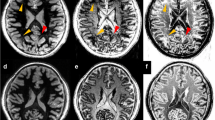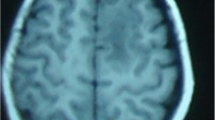Summary
Two children (41/2 and 9 months of age) suffering from tuberous sclerosis were examined with MRI, using a 2.35-Tesla magnet. Both patients showed the typical brain lesions of tuberous sclerosis, namely, subependymal nodules projecting into the lateral ventricles and parenchymal hamartomas. However, in one child the examination revealed subcortical foci of low signal intensity on T2-weighted images and of high signal intensity on T1-weighted images, which could represent fat-containing hamartomas.
Similar content being viewed by others
References
Altman NR, Purser RK, Donovan MJ (1988) Tuberous sclerosis: characteristics at CT and MR imaging. Radiology 167:527–532
Inoue Y, Nakajima S, Fukuda T, Nemoto Y, Shakudo M, Murata R, Matsuoka O, Takemoto K, Matsumura Y, Onoyama Y (1988) Magnetic resonance images of tuberous sclerosis, further observations and clinical correlations. Neuroradiology 30:379–384
Vaghi M, Visciani A, Testa D, Binelli S, Passerini A (1987) Cerebral MR findings in tuberous sclerosis. J Comput Assist Tomogr 11:403–406
McMurdo SK, Moore SG, Brant-Zawadzki M, Berg BO, Koch T, Newton TH, Edwards MSB (1987) MR imaging of intracranial tuberous sclerosis. AJNR 8:77–82
Naidich TP, Zimmermann RA (1987) Common congenital malformations of the brain. In: Brant-Zawadzki M, Norman D (eds) Magnetic resonance imaging of the central nervous system. Raven Press, New York, pp 131–150
Nixon JR, Houser OW, Gomez MR, Okazaki H (1989) Cerebral tuberous sclerosis: MR imaging. Radiology 170:869–873
Terwey B, Doose H (1987) Tuberous sclerosis: magnetic imaging of the brain. Neuropediatrics 18:67–69
Urich H (1976) Malformations of the nervous system, perinatal damage and related conditions in early life. In: Blackwood W, Corsellis JAN (eds) Greenfield's neuropathology, 3rd edn. Arnold, Edinburgh, pp 360–469
Helmke K (1937) Glykogenablagerungen im Gehim bei tuberöser Sklerose. Virchows Arch [B] 300:130–140
Jacob H (1964) Zentralnervöser Zell- und Gewebsdysfunktionen bei tuberöser Sklerose. Arch Psychiatr Nervenheilkd 206: 208–227
Hirano A, Tuazon R, Zimmermann HM (1968) Neurofibrillary changes, granulovacuolar bodies and argentophilic globules observed in tuberous sclerosis. Acta Neuropathol 11:257–261
Kortman KE, Bradley WG (1988) Supratentorial neoplasms. In: Stark DD, Bradley WG (eds) Magnetic resonance imaging. Mosby, St. Louis, pp 375–424
Demas BE, Stafford SA, Hricak H (1988) Kidneys. In: Stark DD, Bradley WG (eds) Magnetic resonance imaging. Mosby, St. Louis, pp 1887–1232
Author information
Authors and Affiliations
Rights and permissions
About this article
Cite this article
Stricker, T., Zuerrer, M., Martin, E. et al. MRI of two infants with tuberous sclerosis. Neuroradiology 33, 175–177 (1991). https://doi.org/10.1007/BF00588263
Received:
Issue Date:
DOI: https://doi.org/10.1007/BF00588263




